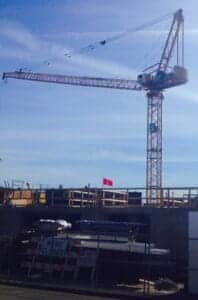This time of year is beautiful in Seattle. Warm weather and clear skies mean more pedestrians, as Seattleites hit the streets for fresh air and exercise.
Meanwhile, Seattle is in the midst of a big construction boom.
You don’t have to walk far to see a new apartment building going up, or one of the dozen or so massive cranes parked downtown.

Construction is dangerous.
Developers are allowed to shut down a sidewalk in front of a construction project.
The closure should be brief and have a clear purpose.
There should be a safe, convenient route around the job site.
But that doesn’t always happen.
- Signs around projects aren’t clear, and people don’t know where to walk;
- A closure starts in the middle of the block; or
- Sidewalks are closed on BOTH sides of a busy street, dumping pedestrians into traffic.
For evidence of these problems, see The City Council is Trying to Kill Pedestrians.
Seattle, despite the “Pedestrian Master Plan,” and ambition to be the Most Walkable City in the Nation, has created some pedestrian danger.
Safety is not incumbent on pedestrians alone. But in the interest of self-preservation, here a few tips for staying safe Seattle streets this spring.
- Pay attention. Put your cell phone in your pocket, and don’t wear headphones or earbuds.
- Obey traffic signals. We expect cars and bikes to obey traffic laws. Do the same when you’re walking.
- Look out ahead. If you can see construction in the next block, divert your route to avoid it.
- Beware the cones. Some sites have orange plastic cones routing pedestrians around closed sidewalks – but they can cut through parking spaces or traffic lanes, putting you very close to moving vehicles.
- Report violations. If you see a construction company closing off a sidewalk without providing a safe, accessible route, report it to the Department of Planning and Development.


